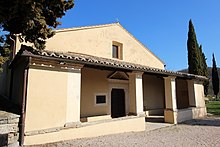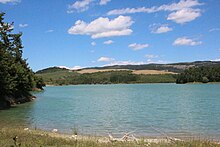San Casciano dei Bagni
| San Casciano dei Bagni | ||
|---|---|---|

|
|
|
| Country | Italy | |
| region | Tuscany | |
| province | Siena (SI) | |
| Coordinates | 42 ° 52 ' N , 11 ° 53' E | |
| height | 582 m slm | |
| surface | 81.86 km² | |
| Residents | 1,575 (Dec. 31, 2019) | |
| Population density | 19 inhabitants / km² | |
| Post Code | 53040 | |
| prefix | 0577 | |
| ISTAT number | 052027 | |
| Popular name | Sancascianesi | |
| Patron saint | San Cassiano di Imola (August 13th) | |
| Website | San Casciano dei Bagni municipality | |
 Panorama of San Casciano dei Bagni |
||
San Casciano dei Bagni ( German about baths of San Casciano ) is an Italian municipality ( comune ) with 1575 inhabitants (as of December 31, 2019) in the province of Siena , Tuscany region .
geography
The place extends over 81.86 km² . It is located about 70 km southeast of the provincial capital Siena and about 110 km southeast of the regional capital Florence on the southern slope of Monte Cetona in the Chiana Valley . It borders on the regions of Umbria and Latium and is in the climatic classification of Italian communities in zone D, 2 333 GG. In the municipality the waters of Paglia (5 of 16 km in the municipality), Fossalto (8 of 10 km in the municipality) and Rigo (also Torrente del Rigo , 7 of 18 km in the municipality) flow . In addition, the Orcia and the Siele touch the municipality. With the exception of the Orcia, all other waters belong to the Tiber river system .
The districts include Celle sul Rigo , Fighine (731 m, approx. 10 inhabitants), Palazzone (408 m, approx. 300 inhabitants), Ponte a Rigo , Sasso (324 m, approx. 20 inhabitants), Stabbiano (358 m, approx. 50 inhabitants) and Stabbiano di Sotto (362 m, approx. 25 inhabitants).
The neighboring municipalities are Abbadia San Salvatore , Acquapendente ( VT ), Allerona (TR) , Cetona , Città della Pieve ( PG ), Fabro (TR), Piancastagnaio , Proceno (VT), Radicofani and Sarteano .
history
The origin and development of the place are related to the thermal baths : There are over 42 springs in the place, which have an average temperature of 40 ° C and which bring about 5.5 million liters of thermal water to the surface every day (third largest amount in Europe).
According to legend, the "Bagni Chiusini" ( Chiusin baths) were founded by the Etruscans and then used by the Romans due to their proximity to Rome and the Via Cassia . After the fall of the Roman Empire, the use of thermal baths declined. The barbarian invasions and wars between Byzantium and the Lombards led to a population decline, especially in the outskirts. In the 11th century , the thermal baths were frequented again thanks to their proximity to the Via Francigena . At that time the place was under the rule of the Visconti di Campiglia , who in turn were dependent on the monastery of San Salvatore di Monte Amiata . The first documents prove that Curtis de Bagno donated the Marchese Ugo di Toscana to the monastery around 995. In the conflict between Ghibellines and Guelphs, the local rulers of the Visconti di Campiglia first decided in favor of the former and supported Siena and Frederick I , but switched to the Guelphs as early as 1215 and thus to Orvieto and Florence , with whom they entered on September 4, 1260 the battle of Montaperti near Siena suffered a defeat against the Ghibellines. At the beginning of the 14th century, the Visconti family split into two lines, on the one hand that of Campiglia d'Orcia (today's district of the municipality of Castiglione d'Orcia ) on the Senese side, on the other hand, those who remained in San Casciano on the Orvieto side and the Monaldeschis . With the peace treaties of 1383 and 1386, San Casciano again approached Siena and finally surrendered on June 15, 1412. In the 16th century, the place was involved in the wars between Florence and Siena, which ended in 1555 with the defeat of Siena and the place made part of the Grand Duchy of Tuscany .
Attractions
- Collegiata dei Santi Leonardo e Cassia , church in the historic town center from the 13th century, which probably originated from the Pieve de Balneo , built in the 12th century . Contains the work Incoronazione della Vergine e santi by Pietro di Francesco Orioli (created around 1490). The campanile was built in 1606, and since 1618 the church has been allowed to bear the title of Collegiata . Was rebuilt from 1760 to 1775 and restored in 1948.
- Castello di Fighine , castle in the district of Fighine, which was first mentioned in writing in 1058 and belonged to the Visconti from Campiglia d'Orcia. In October 1441 the Republic of Siena took over the castle, which in 1446 Bartolomeo di Biagio delle Stine left it as a fief . Between 1451 and 1464 the Castle fell into the hands of the Papal States , 1606 Siena awarded the fief to the family of Angelo del Bufalo Cancellieri, where it remained until the early 19th century.
- Chiesa di San Michele Arcangelo , Pieve in the district of Fighine. Was first mentioned in 1191 and has had its current name since 1591. Contains the work San Michele Arcangel by Francesco Bonichi, created around 1750.
- Chiesa di Santa Maria ad Balnea , also called Chiesa di Santa Maria della Colonna or Cappella dell'Ospizio , church and former pieve from the 12th century near the thermal baths. Is considered the oldest monument of San Casciano dei Bagni. Contains an early 13th century fresco ( Vergine col Bambino ). Next to the church there are the remains of a Franciscan convent that worked here in the 15th century.
- Chiesa della Madonna Bambina , church just outside the town center, which was built in 1579 by the Capuchins . At that time it belonged to the Capuchin convent and is now privately owned.
- Chiesa dei Santi Filippo e Giacomo , former church of the Località Ripe on the road to Sarteano. Today it is privately owned.
- Chiesa di San Paolo Converso , church (Pieve) in the district of Celle sul Rigo, was built in the 13th century. The travertine entrance portal was built in the 14th century and comes from the former church of Sant'Elisabetta.
- Chiesa di San Giovanni Battista , church in the district of Celle sul Rigo, contains the statue of Madonna addolorata from the 18th century.
- Chiesa di Sant'Elisabetta , church ruin in the district of Celle sul Rigo, which was located near the Torre dell'Orologio . Was severely damaged in the 1933 earthquake and disintegrated in 1992.
- Chiesa di Santa Maria Assunta , church in the Palazzone district. First mentioned in 1564, the campanile dates from 1805.
- Chiesa della Madonna delle Grazie , church near the hamlet of Fighine, which was first mentioned in 1582.
- Cappella della Madonna delle Grazie , chapel in front of Celle sul Rigo, has remains of a fresco (Madonna col Bambino) from the 16th or 17th century.
- Lago di San Casciano , lake on the southern edge of the municipality on the border with Acquapendente ( Viterbo province , Lazio ). The lake is considered the northernmost point of the Lazio region.
- Oratorio della Concezione , oratory from the 15th century. Contains the work Allegoria della Concezione by Niccolò Circignani (attributed) and a holy water font from 1596.
- Oratorio di Sant'Antonio , oratory attached to the Collegiata dei Santi Leonardo e Cassia in the historic center. Contains a holy water font dated 1614 and a wooden figure of the Madonna from the late 14th century.
- Porticciola , still existing fortification gate in the lower part of the Borgo (northern gate, also called Porta del Paese).
- Torre dell'Orologio , clock tower in the district of Celle sul Rigo. Was part of the fortifications of Castello Cellese, which were built in the 11th century.
Awards
- San Casciano dei Bagni is the holder of the Bandiera Arancione of the TCI .
- I borghi più belli d'Italia (The most beautiful places in Italy).
Events
- Palio di San Cassiano , again carried out since 1995 Palio , which has its origins in the Middle Ages. The four districts Contrada del Campanile (green and white colors), Contrada del Gattineto (black and yellow colors), Contrada della Porticciola (red and yellow colors) and the Contrada del Pozzo (blue and white colors) compete against each other.
literature
- Laura Martini (ed.): I Luoghi della Fede: Montepulciano e la Valdichiana senese. Arnoldo Mondadori Editore , Milan 1999, ISBN 88-04-46787-8 , pp. 169-175.
- Emanuele Repetti: SAN CASCIANO, o SANCASCIANO DE'BAGNI (ad Balnea Clusina) nella Val di Paglia. In: Dizionario Geografico Fisico Storico della Toscana (1833–1846) , online edition of the University of Siena (PDF, Italian)
Web links
- Official website of the municipality of San Casciano dei Bagni (Italian)
- Website of the Pro Loco of the municipality (Italian)
Individual evidence
- ↑ Statistiche demografiche ISTAT. Monthly population statistics of the Istituto Nazionale di Statistica , as of December 31 of 2019.
- ↑ Website of the Agenzia nazionale per le nuove tecnologie, l'energia e lo sviluppo economico sostenibile (ENEA), accessed on June 20, 2015 (Italian) (PDF; 330 kB)
- ↑ Official website of the Sistema Informativo Ambientale della Regione Toscana (SIRA) on the rivers in San Casciano dei Bagni , accessed on June 20, 2015 (Italian)
- ↑ Official website of the Istituto Nazionale di Statistica (2001), accessed on June 20, 2015 (Italian)
- ↑ Official website of the municipality of San Casciano dei Bagni on the history of the place, accessed on April 8, 2011 ( Memento of the original from December 18, 2010 in the Internet Archive ) Info: The archive link has been inserted automatically and has not yet been checked. Please check the original and archive link according to the instructions and then remove this notice.
- ↑ a b c d e f g h i j k l m Laura Martini (ed.): I Luoghi della Fede: Montepulciano e la Valdichiana senese.
- ^ Ovidio Guaita: Le ville della Toscana , p. 376 ff., Newton & Compton editori, Rome 1997, ISBN 88-8183-787-0
- ↑ Crete di Siena for the Chiesa Santa Maria della Collona, accessed on June 25, 2015 (Italian)
- ↑ a b Archived copy ( memento of the original dated August 13, 2015 in the Internet Archive ) Info: The archive link was inserted automatically and has not yet been checked. Please check the original and archive link according to the instructions and then remove this notice. Website cellesulrigo.com, accessed June 25, 2015 (Italian), no longer available
- ^ Official website of the TCI on the Bandiera Arancione and San Casciano dei Bagni , accessed on June 1, 2015 (Italian)
- ^ I borghi più belli d'Italia. Borghipiubelliditalia.it, accessed August 6, 2017 (Italian).
- ↑ Website of the Palio di San Cassiano , accessed on June 25, 2015 (Italian)





